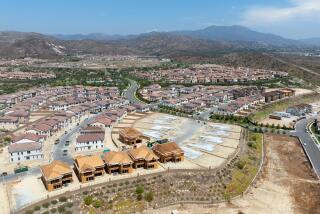FOCUS : WEALTH AND WILDLIFE IN WESTCLIFF
- Share via
Perched on the bluffs high above Upper Newport Bay, many of the homes in this prosperous community command excellent views of both the water and the office towers of distant Newport Center.
Westcliff is older and more established than many other neighborhoods in this Newport Beach area. Its first homes were built in 1962 by the Irvine Co., which sought to blend single-family homes, office buildings, apartments and shopping centers into a village-style living environment.
Over the years, the village concept has been diminished somewhat, as burgeoning strip shopping centers, gas stations and office buildings have diverted crowds of lowlanders off West Coast Highway and up winding Dover Drive to the commercial heart of the area via Westcliff Drive. Today, just 60 acres of Westcliff remain undeveloped.
Away from the mercantile bustle of Westcliff Drive and Irvine Avenue, however, it is still possible to find some semblance of the village life style first conceived a quarter-century ago.
But tranquillity does not come cheaply. At the high end of the real estate spectrum, $5 million will buy an 8,000-square-foot, French country-style estate. The home sits on nearly half an acre and boasts a wine cellar, tennis courts, photo lab and seven bathrooms. Homes closer to the din of commercial streets may be bought for less than $400,000.
But convenient shopping centers and wide-ranging real estate prices are not what make this area unique. At the northeast tip of Westcliff is the largest saltwater marsh area in the county. The Upper Newport Bay Ecological Reserve supports an impressive array of wildlife, including the light-footed clapper rail and Belding’s savannah sparrow--both listed on the state’s roster of endangered species.
These rare birds and hundreds of other species have found sanctuary on the silty clay soil, but a few years ago this vital habitat was in danger of disappearing. A Catch-22 of sorts was at work in the channel of Upper Newport Bay, as the constant build-up of silt caused a substantial reduction in the channel’s tidal action, which in turn caused a further increase in sediment. Essentially, the area was “in danger of reverting from a bay into one big parking lot,” according to a California Department of Fish and Game official. The habitat of thousands of birds, fish and plant life was in serious jeopardy, and the water itself had lost much of its blue-green clarity.
Last year though, an ambitious, 2 1/2-million-cubic-yard dredging program was completed, with the goal of restoring balance to the channel and protecting the reserve. It is too early to gauge the success of the dredging, but Fish and Game officials are confident that their efforts have bought more time for the reserve’s fragile inhabitants.
Visitors interested in seeing the 10,000 to 30,000 shore birds that feed here during the fall and winter should drive or bicycle along Backbay Drive across the bay from Westcliff. The Friends of Newport Bay have been conducting free monthly walking tours of Upper Newport Bay for 20 years and continue them from October to March. For information, call Fran Robinson at (714) 646-8009.
Population Total: (1988 est.) 8,072 1980-88 change: +7.4% Median Age: 42.6 Racial/ethnic mix: White (non-Latino), 94%; Latino, 3%; Black, less than 1%; Other, 3% By sex and age: MALES Median age: 41.0 years FEMALES Median age: 44.4 years Income Per capita: $32,194 Median Household: $50,140 Average Household: $71,236 Income Distribution: Less than $25,000: 21% $50,000-74,999: 20% $25,000-49,999: 29% More than $75,000: 30%


